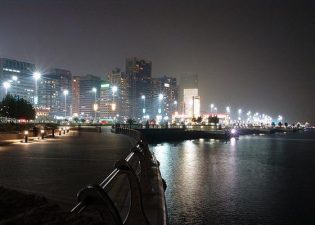 Santorini’s quaint town of Thera actually sits on rim of a super volcano.
Santorini’s quaint town of Thera actually sits on rim of a super volcano.
The Mediterranean Sea basin, especially that bordered by Greece, Turkey, Lebanon and Israel will soon have a new Marine Center that will help to reveal some of the secrets of this ancient and historical body of water. This includes the ancient seaport of Ceasarea, which was built and made famous during the reign of King Herod the Great and was partially destroyed by earthquakes and subsequent tsunami tidal waves such as those caused by mega volcano eruptions in Greece, Crete and Turkey more than 3,000 years ago.
Much historical romanticism surrounds the destruction of the ancient city state of Atlantis; the exact location of which has been said to have been anywhere from islands in the Mediterranean, to an actual continent in either the Atlantic or Indian Oceans.
The mention of Atlantis was written by the Greek poet and historian Homer, who placed the location of Atlantis as being in the present day Greek island of Santorini, which is actually a large and presently dormant “super volcano”.
Santorini is located about 120 km north of Crete, another island whose ancient Minoan culture was said to have been destroyed in the 15th century BCE by a massive volcanic eruption on Santorini, then known as Thera. Santorini’s main town is also named Thera; perhaps out of reverence to what was once a major part of the Minoan Empire.
Whether Atlantis ever existed is still shrouded in mystery and has been the topic for several Hollywood films. What is undeniable fact, however, is the demise of the Crete based Minoan civilization, attributed at least in part by the massive volcanic eruption on Santorini. Recent studies of the Santorini volcano indicate that substantial sub-terrain seismic activity is now occurring there; with a large build-up of magma, a mixture of molten lava and semi-molten rock that has pushed the undersea volcano and island up at least 14 cm (5.5 inches) in the past one and a half years.
The volcano, which has been inactive for the past 25 years, had its last significant eruption in 1950. Area earthquakes, including a serious one in 1956, have been attributed to movement of magma and other volcanic material under the earth. The circular bay between Santorini’s two major islands is actually the Chaldera or submerged cone of the volcano itself.
The Santorini volcano is not the only major volcano to be found in the Mediterranean basin. Italy has three major volcanoes: Vesuvious ( near Naples and the site of the fatal eruption in Roman times that covered up the cities of Herculaneum and Pompei in 79 CE; Mt. Etna in Sicily, still the scene of frequent eruptions. Last, but certainly not least, is the massive Ila Stromboli underwater volcano off southern Italy. This less publicized volcano has erupted continuously for the past 2,000 years.
So much for historical elements. While not that much media attention has so far been given to the current magma build up under the currently sleeping Santorini volcano, a significant eruption complete with earthquakes and huge evictions of volcanic ash and lava would be disastrous for countries in the region.
This especially pertains to Greece, Turkey, Croatia and Montenegro, Cyprus, France, Italy; and also for countries further away. Some of these include Syria, Lebanon, Israel, and all North African countries, including Egypt. Aircraft would not be able to fly in and out of regional airports; and earthquakes caused by the volcano’s eruption could cause serious tsunami tidal waves that haven’t been seen in this region since ancient times.
One might well imagine the effect of 10 to 15 meter high tidal waves on coastal cities like Beirut, Haifa, Tel Aviv and Alexandria. Ancient cities such as Caesarea, Tripoli and Alexandria have all been struck by such waves during their long histories. Such waves, along with the affects of volcanic ash (which blocked out the sun for long periods of time) contributed greatly to the fall of civilizations such as the Minoan one of Crete.
Therefore, what is occurring under the placid sea at Santorini should not be taken lightly.
More about issues affecting the Mediterranean, including earthquakes and volcanoes:
Israel’s Marine Center Will Reveal Sea Secrets
Will Israel’s Undersea Pipeline Increase the Mediterranean’s Already Polluted State?
Ancient Caesarea Needs Every Grain of Sand
Photo of Santorini from Shuutterstock




Comments are closed.